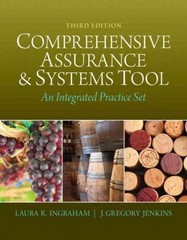Question
eing able to calculate a healthy Margin Analysis will help the Research & Development Department understand how to change the cost of materialand the Production
eing able to calculate a healthy Margin Analysis will help the Research & Development Department understand how to change the cost of materialand the Production Department understand how to change the cost of labor.
You will need:
- The Production Analysis report(page4) of the Capstone Courier for Round 0
- The Segment Analysis reports (pages 5-9) of the Capstone Courier for Round 0
Determining Current Margin
* The product details are for example only. Your product names and data may differ, but the process to calculate margins is identical.
Useful formulas: Contribution Margin($)= Price - (Material Cost + Labor Cost) Margin Percentage (%)= Contribution Margin/Price Calculating MarginActivity
In the table below enter each product's price, material cost, and labor cost found in your report, and note whether or not a second shift was used (Y/N). Then, use the values you entered to calculate the Contribution Margin and the Margin Percentage.
Incomplete
| Current Margin | |||||||
|---|---|---|---|---|---|---|---|
| Product | Name | Price | Material Cost | Labor Cost | Second Shift (Y/N) | Contribution Margin ($) | Contribution Margin (%) |
| Traditional | |||||||
| Low End | |||||||
| High End | |||||||
| Performance | |||||||
| Size |
The Round 0 Capstone Courier Determining Margin Potential
Finding the maximum amount of profit you can generate from one unit of a product is called Margin Potential. This is useful for a company when making a decision about whether to go into production or not. In its simplest form, you can calculate Margin Potential as:
Margin Potential = Maximum Price - Minimum Unit Costs Price
Use the information table below to find the maximum price that customers deem acceptable. You can find this in the Customer Buying Criteria for each segment.
Minimum Material Cost
Calculate the minimum Material Cost per segment using the following equation and table below:
Minimum Material Cost= [(Lowest Acceptable MTBF * 0.30) / 1000] + Trailing Edge Position Cost
Minimum Labor Cost
Calculate the minimum Labor Cost for each segment. Assume a base labor cost of $11.20 ($11.20 is a rough estimate of labor cost used solely to illustrate the Margin Potential Concept). Minimum Labor Cost= [$11.20 - (1.12 * Automation Ratings Below)] + 1.12
| Customer Segment Information | |||||
|---|---|---|---|---|---|
Segments | Trailing Edge Material Cost | Leading Edge Material Cost | Lowest Acceptable MTBF | Maximum Price | Automation Level (out of 10) |
| Traditional | $3.80 | $7.80 | 14,000 | $30.00 | 8.0 |
| Low End | $1.00 | $5.00 | 12,000 | $25.00 | 10.0 |
| High End | $6.00 | $10.00 | 20,000 | $40.00 | 5.0 |
| Performance | $4.50 | $8.50 | 22,000 | $35.00 | 6.0 |
| Size | $4.50 | $8.50 | 16,000 | $35.00 | 6.0 |
| Margin Potential | |||||||
|---|---|---|---|---|---|---|---|
| Product | Name | Maximum Price | Minimum Material Cost | Minimum Labor Cost | Contribution Margin ($) | Contribution Margin (%) | |
| Traditional | |||||||
| Low End | |||||||
| High End |
Step by Step Solution
There are 3 Steps involved in it
Step: 1

Get Instant Access to Expert-Tailored Solutions
See step-by-step solutions with expert insights and AI powered tools for academic success
Step: 2

Step: 3

Ace Your Homework with AI
Get the answers you need in no time with our AI-driven, step-by-step assistance
Get Started


